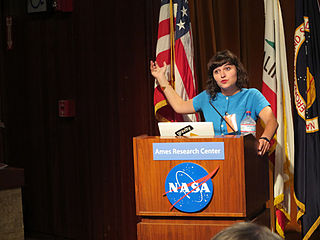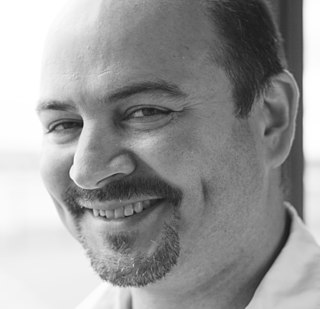
A hackathon is an event where people engage in rapid and collaborative engineering over a relatively short period of time such as 24 or 48 hours. They are often run using agile software development practices, such as sprint-like design wherein computer programmers and others involved in software development, including graphic designers, interface designers, product managers, project managers, domain experts, and others collaborate intensively on engineering projects, such as software engineering.
Storefront for Art and Architecture is an independent, non-profit art and architecture organization located in SoHo, Manhattan in New York City. The organization is committed to the advancement of innovative positions in architecture, art and design.
Social design is the application of design methodologies in order to tackle complex human issues, placing the social issues as the priority. Historically social design has been mindful of the designer's role and responsibility in society, and of the use of design processes to bring about social change. Social design as a discipline has been practiced primarily in two different models, as either the application of the human-centered design methodology in the social sector or governmental sector, or sometimes is synonymously practiced by designers who venture into social entrepreneurship.
The World Design Organization (WDO) was founded in 1957 from a group of international organizations focused on industrial design. Formerly known as the International Council of Societies of Industrial Design, the WDO is a worldwide society that promotes better design around the world. Today, the WDO includes over 170 member organizations in more than 40 nations, representing an estimated 150,000 designers.

Juha Ilmari Leiviskä is a prominent Finnish architect and designer. He is especially known for his churches and other sacral buildings.

The International Council of Design is an international organisation representing the professions of design. The Council was founded in London in 1963 and celebrated its 50th anniversary on 27 April 2013. It is a non-profit, non-partisan, "member-based network of independent organisations and stakeholders working within the multidisciplinary scope of design."

The Linux Foundation (LF) is a non-profit technology consortium that hosts and promotes the collaborative development of open-source software projects. In addition to providing a neutral home where Linux kernel development can be protected and accelerated, the LF is dedicated to building sustainable ecosystems around open-source projects to accelerate technology development and commercial adoption.

Oren Safdie is a Canadian-American-Israeli playwright and screenwriter, and the son of architect Moshe Safdie.

Aalto University is a public research university located in Espoo, Finland. It was established in 2010 as a merger of three major Finnish universities: the Helsinki University of Technology, the Helsinki School of Economics and the University of Art and Design Helsinki. The close collaboration between the scientific, business and arts communities is intended to foster multi-disciplinary education and research.

Indaba Music is a web-based company that provides a music collaboration environment for musicians: "a place to build a profile, promote their tunes and collaborate with other musicians" as well as enter opportunities like remixing and songwriting contests with popular artists.

The Urban Design Forum is a not-for-profit New York organization devoted to urban design. It seeks to amplify the influence and understanding of urban design's role in creating dynamic, cooperative, competitive, and sustainable cities. The organization was formed from the merger of the Institute for Urban Design and the Forum for Urban Design in March 2014.

Nelly Ben Hayoun is a French designer, artist and filmmaker. Born in Valence, Drôme, France, she now resides in London, United Kingdom. She serves on the Advisory Council of METI and is the designer of experiences at the SETI Institute. She is also an exhibitor and keynote speaker who has worked with museums and design centres across the world.

The Helsinki Central Library Oodi, commonly referred to as Oodi, is a public library in Helsinki, Finland. The library is situated in the Kluuvi district, close to Helsinki Central Station and next to Helsinki Music Centre and Kiasma Museum of Contemporary Art. Despite its name, the library is not the main library in the Helsinki City Library system, which is located in Pasila instead.

Craig Edward Dykers is an American architect and founding partner of the architecture firm, Snøhetta.

Design Indaba is a trademark and brand founded and run by Interactive Africa in 1995 with a focus on design and under the slogan "A better world through creativity". Consisting of an online publication and a series of events and creative projects, it is most widely known for its annual festival held in South Africa, in particular the flagship three-day conference hosted in Cape Town. The Design Indaba Conference is also broadcast live to various cities, most recently including Johannesburg, Durban, Nairobi, Windhoek, Kampala and Lausanne. It has also been referred to as the "Conference on Creativity".

Fashion Revolution is a not-for-profit global movement represented by The Fashion Revolution Foundation and Fashion Revolution CIC with teams in over 100 countries around the world. Fashion Revolution campaigns for reform of the fashion industry with a focus on the need for greater transparency in the fashion supply chain. Starting in 2013, Fashion Revolution has designated the anniversary of the Rana Plaza disaster in Bangladesh as Fashion Revolution Day and holds events each year. Between 2014 and 2020, millions of people around the world called on brands to answer the question Who Made My Clothes? The hashtag #WhoMadeMyClothes became the no.1 global trend on Twitter. They have faced criticisms specifically about the Transparency Index.

Wiki Indaba is an official conference of the Wikimedia Foundation with interest in African content. Topics of presentation and dialogue include Wikimedia projects such as Wikipedia, other wikis, open-source software, free knowledge, free content and how these projects affect the African continent.
Ravi Naidoo is the founder of Interactive Africa and Design Indaba, an annual three day design conference hosted in Cape Town, South Africa, as well as a suite of events such as Design Commons and antenna. Naidoo is also a co-founder of the Cape Innovation and Tech Initiative (CiTi) and Rain, Africa's first 5G network.
The Arch for Arch is an architectural structure and monument located in Cape Town, South Africa, created to commemorate the life and work of Desmond Tutu. Commissioned by Design Indaba and sponsored by Liberty, its name is a play on Tutu's widely used nickname, "The Arch". A smaller version of the monument is located in Johannesburg, South Africa at Constitution Hill.
African design encompasses many forms of expression and refers to the forms of design from the continent of Africa and the African diaspora including urban design, architectural design, interior design, product design, art, and fashion design. Africa's many diverse countries are sources of vibrant design with African design influences visible in historical and contemporary art and culture around the world. The study of African design is still limited, particularly from the viewpoint of Africans, and the opportunity to expand its current definition by exploring African visual representations and introducing contemporary design applications remains immense.













